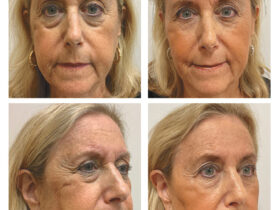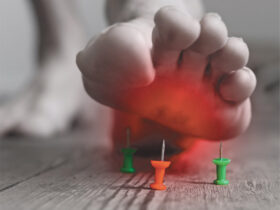By Dr. John P. Landi, MD, FACS, RPVI, RPhS, Diplomate of The American Board
of Venous and Lymphatic Medicine
Varicose and Spider Veins affect millions of people throughout the world. Over the last ten years the treatment of both Varicose and Spider Veins has changed drastically. Initially, the only available treatment for Varicose Veins was a radical surgical procedure called “Ligation and Stripping” which required multiple incisions and multiple stitches. This has now been replaced by techniques to close the leaking valves of the veins with either a Laser or Radio Frequency instrument. Spider Veins which were initially treated only with an irritating saline solution with multiple potential side effects has largely been replaced by Foamed Sclerotherapy which has excellent results and very few side effects.
In my vein practice there are a multitude of commonly asked questions concerning veins and these will be addressed in the next few paragraphs.
The most common question that is proposed to me concerning Varicose Veins is “What Causes Varicose Veins“. Varicose Veins have many factors that can lead to their formation. The most common reason for Varicose Veins to form is strictly a heredity component. If one’s mom or dad has Varicose Veins then there is a strong propensity for this to be passed on to their children. The second common cause of Varicose Veins in women are pregnancies. This is due to the uterus putting pressure on the pelvic veins resulting in weakening of the valves leading ultimately to Varicose Veins. Other common causes of Varicose Veins are trauma, prolonged standing, aging and prolonged inactivity.
The second common question is what are the complications of Varicose Veins. Varicose Veins can lead to many potential complications. These can include clots in the veins which is called “Superficial Phlebitis” or “Superficial Thrombophlebitis”. In addition to that, Varicose Veins can bleed. They can lead to “Ulcerations” and they can lead to a condition called “Chronic Venous Insufficiency” which is a discoloration and swelling of the leg from backup of blood over a long period of time.
The third question often asked of veins is, are the treatments of Varicose Veins and Spider Veins con-
sidered “Cosmetic”. The answer to this question can be both Yes and No. Varicose Veins are almost always a non cosmetic issue when it can be proven that they are due to Valvular Insufficiency. Valvular Insufficiency is proven by an extensive Venous Ultrasound. Spider Veins on the other hand can be due to Valvular Insufficiency in approximately a third of insistences. However, if there is no Valvular Insufficiency demonstrated then Spider Veins would be considered strictly cosmetic.
The fourth question is “What is Phlebitis”. Phlebitis is essentially an inflammation of the veins and there are two kinds of Phlebitis. One is called Superficial Phlebitis or Superficial Thrombophlebitis which is due to a clot in a Varicose Vein. This is usually treated with warm compresses and anti-inflammatory medication and usually resolves within ten days to two weeks. There is a very low threat of this progressing to a Deep Thrombophlebitis and Pulmonary Embolism. On the other hand, Deep Venous Thrombophlebitis is a clot of the deeper veins, namely the Femoral and Popliteal Veins and also the Iliac Veins. These are veins located deep in the body. Clots that develop in these areas are serious and must be treated with anticoagulation consisting usually with Heparin and Coumadin. They also have a risk of breaking off and going to the lungs to cause Pulmonary Embolisms.
Do Varicose Veins recur after treatment?
The recurrence rate of Varicose Veins after Vein Closure Treatment is approximately five percent within five years. If veins do occur then a source for the recurrence must be established. This could be other valves that have reopened or Accessory Veins that have formed or even missed or duplicated veins. Again, this can be ascertained by a Duplex Ultrasound.
How do you treat Varicose Veins?
The treatment of Varicose Veins as mentioned in the first paragraph, is to close the leaking valves with either a Laser or Radio Frequency device. This is done in an office environment under a local anesthesia with mild sedation and carries an excellent cosmetic result. There is no longer any need for extensive incisions or any prolonged surgery.
How do you treat Spider Veins?
Spider Veins are treated by Sclerotherapy which is the injection of a solution to eradicate the vein. There are many forms of Scerotherapy including, Liquid Sclerotherapy, Ultrasonic Guided Sclerotherapy and Foamed Sclerotherapy. There are also many kinds of Sclerotherapy agents including, the detergent agent sodium tetradecyl and the irritant glycerin. The old Sclerotherapy of Hypertonic Saline is rarely used.
What happens to blood in the leg after Varicose Veins are treated?
This is one of my most commonly asked questions in patients who undergo Laser Vein Ablation. One must remember that the Saphenous Vein is a Superficial Vein. So, in treating this vein we are only treating veins in the Superficial System. There are actually three levels of veins in the body. A Superficial System, a Deep System and a Connecting System. The Deep and Connecting Systems are not touched, therefore, once the Superficial System is closed, blood will flow normally through the Connecting System to the Deep System without any change in the function of the leg.
Another commonly asked question is, for how long do I wear Compression Hose following Vein Treatment?
As a rule of thumb, following Laser Vein Ablation or Radio Frequency Ablation, 2 weeks of compression therapy used to be recommended but now 2 to 3 days of compression is all that is ncecessary.
How is the diagnosis of Valvular Insufficiency made?
The answer to this question is that an extensive Duplex Ultrasound of the Venous System will make the diagnosis of Valvular Insufficiency. This should be done by a Certified Technician and interpreted by a Physician Certified to read Duplex Ultrasounds.
Dr. John P. Landi is medical director of Vanish Vein and Laser Center, a state of the art, dedicated vein treatment center. He is one of less than 2,000 physicians worldwide to achieve the designation of Diplomate of the American Board of Venous and Lymphatic Medicine. He is a fellow of the American College of Surgeons, a fellowship trained vascular surgeon, Board Certified in General Surgery and has achieved both the RPVI and RPhS certifications in vascular ultrasound.
9950 Tamiami Trail North, Naples 34108
239-403-0800
www.VanishVein.com









